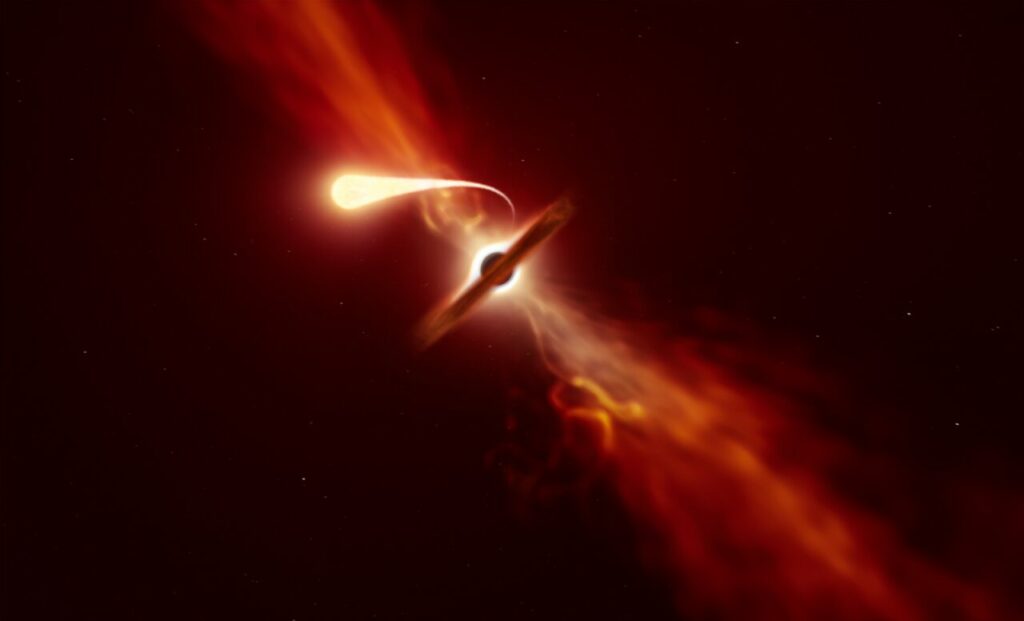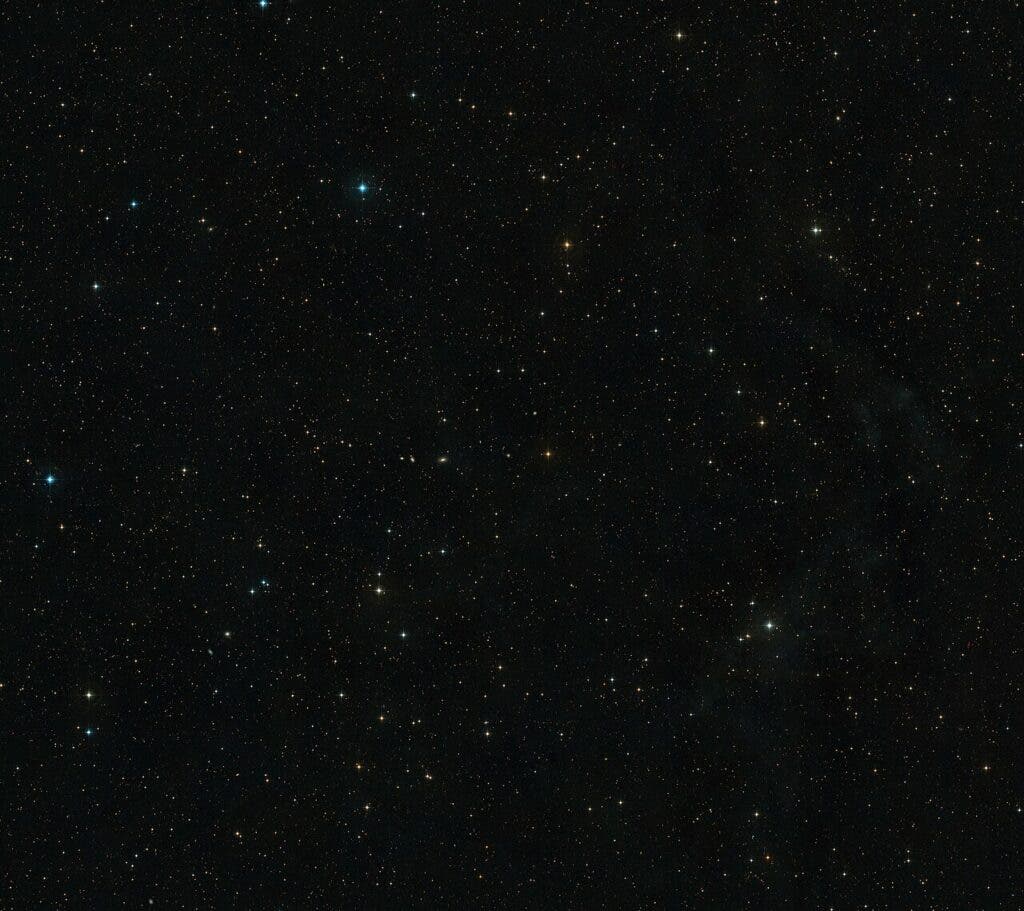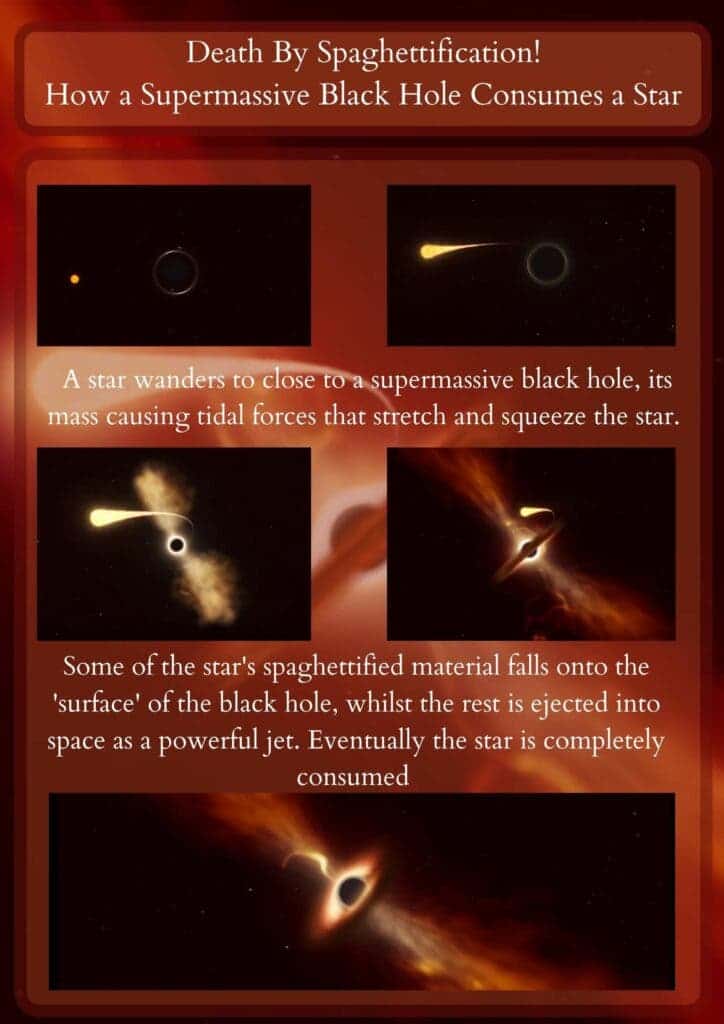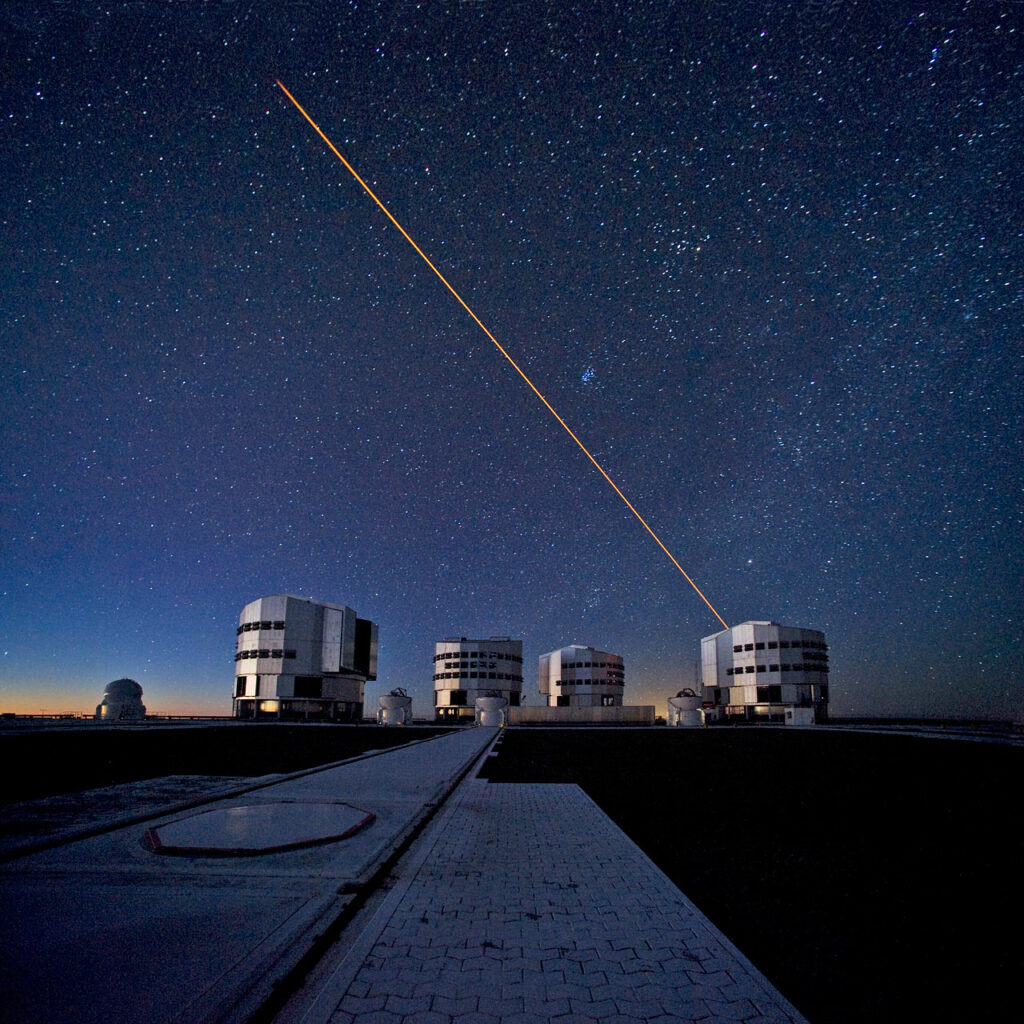An international team of researchers has used telescopes from around the world — including instruments operated by the European Southern Observatory (ESO) — to glimpse a blast of light emitted by a star as it is torn apart by the tidal forces of a supermassive black hole.
The event — technically known as a ‘tidal disruption event’ (TDE) — occurred 215-million light-years from Earth, but despite this intimidating sounding distance, this is the closest to our planet such a flare has ever been captured. This, and the fact the astronomers spotted the event early, means the team was able to study the phenomena in unprecedented detail, in turn uncovering some surprises in this violent and powerful process.

The astronomers directed the ESO’s Very Large Telescope (VLT), based in the Atacama desert, Chile, and other instruments at a blast of light that first occurred last year. They studied the flare, located in AT2019qiz in a spiral galaxy in the constellation of Eridanus, for six months as it grew in luminosity and then faded. Their findings are published today in the Monthly Notices of the Royal Astronomical Society.
“My research focuses on close encounters between stars and supermassive black holes in the centres of galaxies. Gravity very close to a black hole is so strong that a star cannot survive, and instead gets ripped apart into thin streams of gas,” Thomas Wevers, co-author of the study and an ESO Fellow in Santiago, Chile, tells ZME Science. “This process is called a tidal disruption event, or sometimes ‘spaghettification’.
“If not for such tidal disruption events, we would not be able to see these black holes. Hence, they provide a unique opportunity to study the properties of these ‘hidden’ black holes in detail.”
Thomas Wevers, ESO Fellow
Catching the Start of the Movie
Wevers, who was part of the Institute of Astronomy, University of Cambridge, UK, as the study was being conducted, explains that it can take several weeks — or even months — to identify these spaghettification events with any certainty. Such an identification also takes all the telescopes and observational power that can be mustered. This can often cause a delay that results in astronomers missing the early stages of the process.

“It’s like watching a movie but starting 30 minutes in, a lot of information is lost if you can’t watch from the very beginning, and while you might be able to reconstruct roughly what has happened, you can never be completely sure,” the researcher explains. But, that wasn’t the case with this new event.
To stick to the analogy; this time the team had their popcorn and drink and were in their seats before the trailers started rolling.
“In this new event, we were lucky enough to identify and hence observe it very quickly, which has allowed us to see and understand what happens in the early phases in great detail.”
Thomas Wevers, ESO Fellow
Spotting spaghettification events is not just difficult due to timing issues, though. Such events are fairly rare, with only 100 candidates identified thus far, and are often obscured by a curtain of dust and debris. When a black hole devours a star, a jet of material is launched outwards that can further obscure the view of astronomers. The prompt viewing of this event allowed that jet to be seen as it progressed.
“The difficulty comes first from picking out these rare events in among all the more common things changing in the night sky: variable stars and supernova explosions,” Matt Nicholl, a lecturer and Royal Astronomical Society research fellow at the University of Birmingham, UK, and the lead author of the study tells ZME Science. “A second difficulty comes from the events themselves: they were predicted to look about 100 times hotter than the flare that we observed. Our data show that this is because of all the outflowing debris launched from the black hole: this absorbs the heat and cools down as it expands.”
Spaghettification: Delicious and Dangerous
The spaghettification process is one of the most fascinating aspects of black hole physics. It arises from the massive change in gravitational forces experienced by a body as it approaches a black hole.
“A star is essentially a giant ball of hot, self-gravitating gas, which is why it is roughly spherical in shape. When the star approaches the black hole, gravity acts in a preferential direction, so the star gets squeezed in one direction but stretched in the perpendicular direction,” Wevers says. “You can compare it to a balloon: when you squeeze it between your hands, it elongates in the direction parallel to your hands. Because the gravity is so extreme, the result is that the star essentially gets squeezed into a very long and thin spaghetti strand — hence the name spaghettification.”

Death by Spagettification! (ESO/M. Kornmesser/ Robert Lea)
Nicholl continues, explaining what happens next to this stellar spaghetti strand: “Eventually, it wraps all the way around and collides with itself, and that’s when we start to see the light show as the material heats up before either falling into the black hole or being flung back into space.
“The distance at which the star encountered the supermassive black hole was around the same distance between the Earth and Sun — this shows how incredibly strong the gravitational pull of the black hole must be to be able to tear the star apart from that distance.”
“If you picture the Sun being torn into a thin stream and rushing towards us, that’s roughly what the black hole saw!”
Matt Nicholl, Royal Astronomical Society research fellow.
Suprises and Future Developments
The observations made by the astronomers have allowed them to study the dynamics of a star undergoing the spaghettification process in detail, something that hasn’t been possible before. And as is to be expected with such a first, the study yielded some surprises for the team.
“The biggest surprise with this event was how rapidly the light brightened and faded,” Nicholl tells ZME. “It took about a month from the encounter for the flare to reach its peak brightness, which is one of the fastest we’ve ever seen.”
The researcher continues to explain that faster events are harder to find, so it suggests that there might be a whole population of short-lived flares that have been escaping astronomers’ attention. “Our research may have solved a major and long-standing mystery of why these events are 100 times colder than expected — in this event, it was the outflowing gas that allowed it to cool down.”
Confirming this idea means that the team must now seek scarce telescope time to investigate more of these events to see if this characteristic is unique to the AT2019qiz flare, or if it is a common feature of such events. “Because we studied only one event, it is still unclear whether our results apply universally to all such tidal disruption events. So we need to repeat our experiment multiple times,” Wevers says. “Unfortunately, we are at the whims of nature and our ability to spot new TDEs. When we do, we will need to confirm the picture we have put forward or perhaps adapt it if we find different behaviour.”

Wevers concludes by highlighting the unique position he, Nicholl, and their team find themselves in by studying such rare and difficult to observe events and the objects that lie behind them. “We aren’t yet in the phase where we think we have mapped all the behaviour that occurs following these cataclysmic events, so while each new TDE helps us to answer outstanding questions, at the same time it also raises new questions.
“We find ourselves continually in a catch-22 like situation, which in this case is a good thing as it propels our research forward!” exclaims Wevers. “I find it pretty amazing that we can study gargantuan black holes, weighing millions or even billions of times the mass of our sun, and which are located hundreds of millions of light-years away, in such detail with our telescopes.”
Original research: Nicholl. M., Wevers. T., Oates. S. R., et al, ‘An outflow powers the optical rise of the nearby, fast-evolving tidal disruption event AT2019qiz,’ Monthly Notices of the Royal Astronomical Society, [2020].


